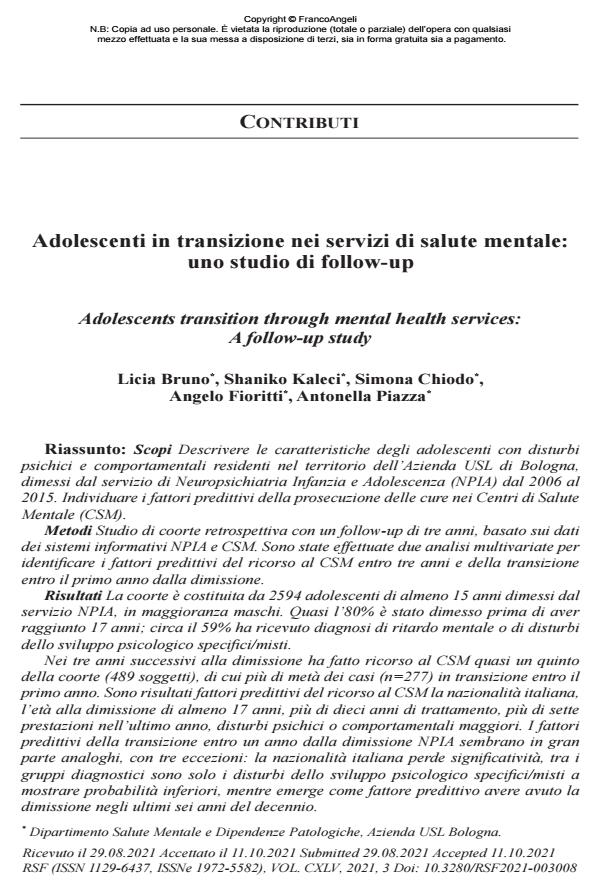Adolescents transition through mental health services: A follow-up study
Journal title RIVISTA SPERIMENTALE DI FRENIATRIA
Author/s Licia Bruno, Shaniko Kaleci, Simona Chiodo, Angelo Fioritti, Antonella Piazza
Publishing Year 2021 Issue 2021/3
Language Italian Pages 21 P. 111-131 File size 259 KB
DOI 10.3280/RSF2021-003008
DOI is like a bar code for intellectual property: to have more infomation
click here
Below, you can see the article first page
If you want to buy this article in PDF format, you can do it, following the instructions to buy download credits

FrancoAngeli is member of Publishers International Linking Association, Inc (PILA), a not-for-profit association which run the CrossRef service enabling links to and from online scholarly content.
Aims To examine the characteristics of adolescents with mental and behavioural disorders residents in the metropolitan area of Bologna (Italy), discharged from child and adolescent mental health services (CAMHS) between 2006 and 2015. To identify the predictive factors of continuation of care in community mental health services for adults (AMHS). Methods Retrospective cohort study with a three-year follow-up. Data were retrieved from CAMHS and AMHS information systems. Two multivariate analyses were performed, aimed at identifying the predictive factors of transfer to AMHS during the follow-up, as well as of transition within one year from CAMHS discharge. Results The study cohort included 2594 subjects 15-year-old and over, discharged from CAMHS, predominantly males. Near 80% were discharged under the age of 17. Those diagnosed with mental retardation or specific/mixed developmental disorders were 58,6%. Almost a fifth of the cohort (489 cases) moved to AMHS during the three-year follow-up; more than half of them (n=277) transitioned within one year. Some predictive factors of continuation of care in AMHS were highlighted: being at least 17-year-old and Italian, having more than ten years of CAMHS treatment and more than seven consultations in the last year of treatment, and being diagnosed with a severe mental disorder. The predictive factors of transition within one year were similar, but the significance of Italian citizenship was lost, cases with specific/mixed developmental disorders were less likely to transition, and those discharged from CAMHS in the last six years of the decade showed higher odds. Conclusions As highlighted by previous research, relatively small numbers of adolescents discharged from CAMHS gained access to AMHS. The likelihood of transfer to AMHS seemed to be greater for CAMHS patients with more intensive and long-lasting treatments and severe mental disorders. Transition to AMHS was more likely in the last six years of the decade, possibly as a result of organizational improvements, such as close monitoring and shared protocols for referrals. However, the overall findings raise questions on treatment gaps and actions to be undertaken for their reduction.
Keywords: Child and Adolescence Mental Health Services, Community Mental Health Services, Predictive factors, Continuity of care.
Licia Bruno, Shaniko Kaleci, Simona Chiodo, Angelo Fioritti, Antonella Piazza, Adolescenti in transizione nei servizi di salute mentale: uno studio di follow-up in "RIVISTA SPERIMENTALE DI FRENIATRIA" 3/2021, pp 111-131, DOI: 10.3280/RSF2021-003008